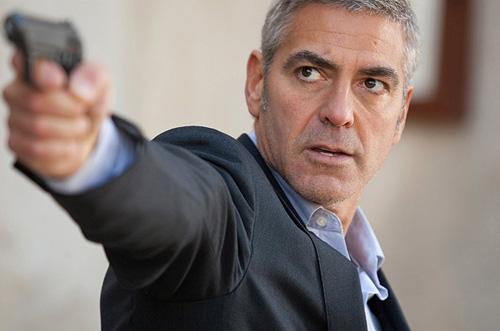The American is Jack, a semi-retired assassin and master
gunsmith enjoying a reclusive R & R in a Swedish hideaway with
a bare-assed beauty. But any assumption that this is going to be a
James Bond-style romp is quickly dispelled when the two lovers take
a post-coital walk on a snow-covered lake where shots are fired,
and three people (including the girl), end up dead. Escaping to
Italy, Jack meets his Belgian handler (Johan Laysen) who provides a
cell phone, and the keys to a car. “Who was the girl?” the handler
asks. “A friend,” Jack replies, and with obvious disdain the other
man says, “You should know better than to make friends.”
Jack is played by the grizzled but still gorgeous George Clooney
as “A Very Private Gentleman” (the name of Martin Booth’s novel on
which the film is based). Holed up in an Italian mountain village,
and despite his best efforts to retain his privacy, Jack still
makes a couple of friends. One of these is Father Benedetto (Paolo
Bonecelli), an old priest who invites Jack to share some local
brandy and then pumps the newcomer with probing questions into his
past. Later, after several conversations, the priest sums up Jack’s
life by saying “You can’t deny the existence of Hell…You are living
it.”
Jack’s other friend comes from an unlikely source—a brothel.
“I pay for my pleasure…not yours,” he tells Clara (Violante
Placido). Eventually, the two schedule time for dinner at a
restaurant with white tablecloths, a picnic on a secluded
riverbank, and the chance to watch a religious procession.
The Swedes have somehow managed to track Jack to his hiding
place, and after several nights of cat-and-mouse stalking, an
attempt is made on Jack’s life. This sequence, shot in the
claustrophobic puzzle of the village’s stair-step alleyways,
highlights the difference between this movie and an American-made
blockbuster film like “The Bourne Identity.” No series of frantic
intercuts here. Instead, Dutch director Anton Corbijn is a master
photographer and his artistry shows. Overhead shots lay out the
crazy-quilt asymmetry of tile-covered roofs connected by
cobblestone paths and stairways. At ground level, those same
convoluted passageways take abrupt turns into darkened recesses
perfect for a gunman’s hiding place. Jack removes his shoes, and
carefully places them in a hidden spot for eventual collection. The
weapon used by his Scandinavian stalker already has a silencer
attached, and when Jack attaches one to his pocket-sized gun as
well, the mouse becomes the stalker.
You may not know that one of the main reasons American movie
studios keep making films filled with extended explosions, car
chases and battle scenes, is that they contain relatively little
dialogue and are easily dubbed for lucrative foreign release. This
film also has the feeling of being made for both North America and
Europe. Actors in secondary roles often talk with their face (and
mouth) pointed away for easier dubbing. Clooney is the only
American actor in the film and the presence of a European cast,
(Swedes, Belgians, Italians, and Dutch, just to name a few) means
the movie can be easily made in a dozen languages. Sometimes you
notice that a sequence (like one on the riverbank) somehow seems to
be missing a few parts. One obvious change is where Clara goes
swimming in the river. In the version shown in U.S. theaters, she
is topless, but in the online preview, she is in a bikini. Perhaps
in some countries, she swims nude onscreen.
But the most European part of this film is the pacing. The movie
is put together with the painstaking skill needed to hand-make a
rifle. Slowly, carefully, individual pieces are created, polished
and test fit until they are finally assembled. This movie does the
same thing. Just like Clooney’s character, everything is carefully
calculated. Every scene takes its time to come together into a
final conclusion that reiterates that despite its title, “The
American” is decidedly not American-made.
Comments? E-mail
gi*********@co*****.net
.
54.1
F
Healdsburg
November 17, 2024








